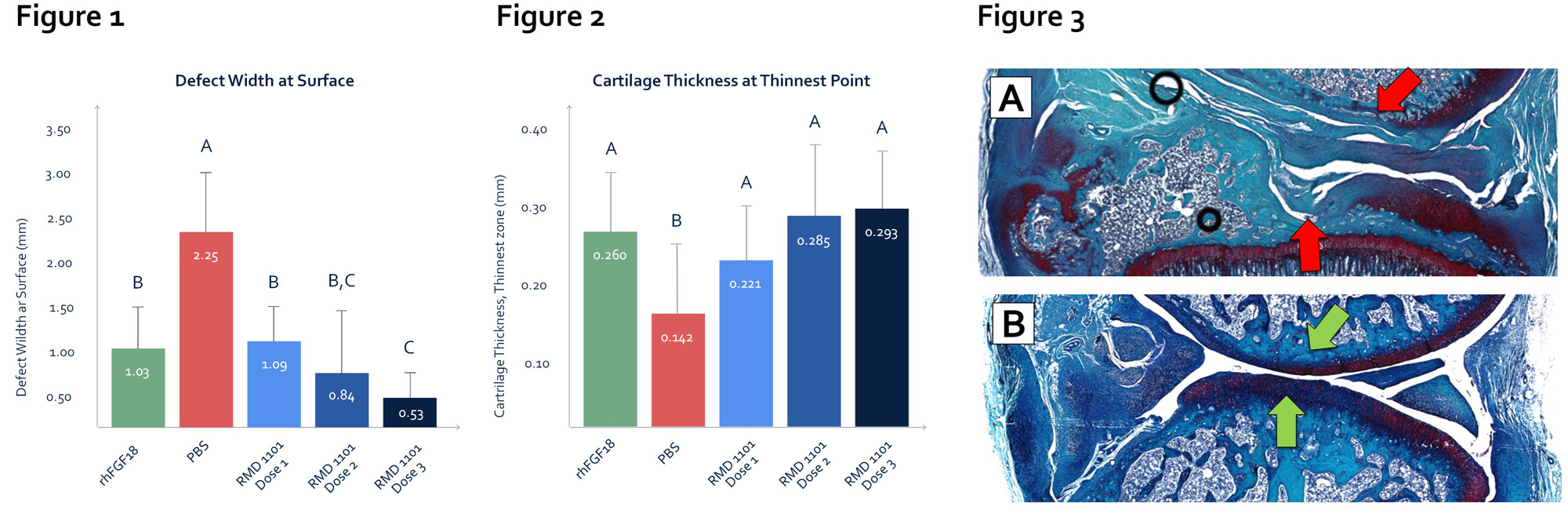Session Information
Date: Monday, November 13, 2023
Title: (0859–0885) Osteoarthritis & Joint Biology – Basic Science Poster
Session Type: Poster Session B
Session Time: 9:00AM-11:00AM
Background/Purpose: Osteoarthritis (OA) is the largest unmet need in rheumatology, affecting 1 in 7 adults, with no approved disease modifying treatments. A recent placebo-controlled clinical study of rhFGF18 demonstrated, for the first time, the ability to reverse cartilage loss in OA – with the highest dose/frequency arresting progression to joint replacement. While promising, the safety and efficacy of this approach is limited by the required frequency of intra-articular injections, due to synovial joint pharmacokinetics. In this study, we compared the effects of repeated rhFGF18 protein injections and a single injection AAV2-hFGF18 on cartilage anabolism in healthy and arthritic joints.
Methods: Chondrogenic properties of AAV2-hFGF18 were compared to rhFGF18 protein, AAV2-GFP, and PBS. Cytocompatibility was assessed by cellular viability over 168h in culture. Gene expression was analyzed by RNA-seq on primary human chondrocytes. In vivo durability of gene expression was confirmed using bioluminescence imaging. Cartilage anabolism was evaluated by measuring thickness of the tibial plateau in 300-375g healthy and OA male Sprague-Dawley rats, with OA induced by destabilization of the medial meniscus. Effect on disease progression was assessed by measuring cartilage defect width and depth following administration of AAV2-hFGF18, rhFGF18 protein, and PBS.
Results: At multiplicities of infection (MOIs) of 0.1k and 1k, AAV2-hFGF18 induced proliferative increases of 36 and 84%, respectively, which was in line with rhFGF18 protein dosed at 1-10k ng/ml (38-110%), and statistically above PBS (8%). At the same time, AAV2 demonstrated cytocompatibility through MOIs up to 50k. RNA-seq revealed rhFGF18- and AAV2-hFGF18-induced upregulation of hyaline cartilage-associated HAS2 and COL2A1, and downregulation of fibrocartilage-associated COL1A1. AAV2-hFGF18, but not rhFGF18, upregulated SOX9, a chondrocyte differentiation marker, and PRG4, an articular cartilage lubricating protein, while downregulating the aggrecan-targeting protease ADAMTS15. Compared to healthy cartilage, a significantly more pronounced chondrogenic effect was observed in arthritic joints. Defect widths were reduced in the gene therapy-treated knees by 51.6 – 76.4% relative to PBS, with the highest dose achieving statistical significance over rhFGF18 (54.2% reduction) (Fig 1). Similarly, cartilage thickness at the thinnest point increased in the gene therapy treated joints, reaching 2.06x of PBS (Fig 2). Severe OA pathology was observed in the placebo-treated knees (Fig 3A), including significant cartilage loss, subchondral bone collapse, and formation of bone voids; in contrast, such phenotypes were not observed in the high-dose gene therapy group (Fig 3B). Finally, repeat injections of rhFGF18, while chondroprotective, induced synovitis-mediated joint swelling even in healthy joints, that remained unresolved through 2-months post treatment.
Conclusion: Our findings suggest that a single injection of AAV2-hFGF18 demonstrates superior safety and efficacy over a multi-injection rhFGF18 protein treatment regimen in a model of Osteoarthritis.
To cite this abstract in AMA style:
Goraltchouk A, Hollander J, Luppino F, Zeng L, Seregin A. Single Injection AAV2-hFGF18 Demonstrates Superior Safety and Efficacy over Repeat rhFGF18 Protein Injections in a Model of Induced Osteoarthritis [abstract]. Arthritis Rheumatol. 2023; 75 (suppl 9). https://acrabstracts.org/abstract/single-injection-aav2-hfgf18-demonstrates-superior-safety-and-efficacy-over-repeat-rhfgf18-protein-injections-in-a-model-of-induced-osteoarthritis/. Accessed .« Back to ACR Convergence 2023
ACR Meeting Abstracts - https://acrabstracts.org/abstract/single-injection-aav2-hfgf18-demonstrates-superior-safety-and-efficacy-over-repeat-rhfgf18-protein-injections-in-a-model-of-induced-osteoarthritis/

